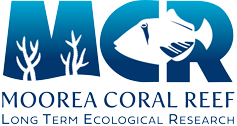Year:
2022
Authors:
Source:
M.S. Thesis
Abstract:
Organism size is a critical biological characteristic that affects traits ranging from the fitness of organisms to the dynamics of ecosystems. This thesis focuses on tropical reef corals and explores the implications of coral size on metabolic rates and competitive outcomes. In Chapter II, I test the hypothesis that metabolic scaling differs among brooded and broadcasted larvae and juvenile colonies of different taxa. The study objectives were achieved using a compilation of published respiration rates and empirical data collected in Moorea, French Polynesia. Metabolic isometry was found in broadcasted larvae and Pocillopora spp. juveniles, but metabolism was allometric in Porites spp. juveniles. Contrary to the pervasive coupling of metabolism and size in biology, metabolism was independent of size in brooded larvae. Exploring the scaling of tissue biomass and protein in juvenile colonies revealed a correlation between the scaling of biomass with size and metabolic scaling. Together, these results suggest that metabolic scaling in corals is context dependent and are potentially driven by differences in area-normalized biomass and tissue composition. In Chapter III, I investigated Porites astreoides in St. John, US Virgin Islands, to test the hypothesis that coral-algal competitive outcomes are dependent on coral size and scales with an exponent (b) of -0.51 which is based on the scaling of coral perimeter on surface area. Coral dimensions were hypothesized to influence coral-algal interactions because corals acquire resources across their surface area and it is theorized that the resources are diverted to the perimeter to defend against benthic competitors. As P. astreoides increased in size, smaller proportions of the total interaction length with macroalgae (b = -1.0) and turf algae (b = -0.18) were being overgrown by algae. However, there was no dependency of the outcome of interactions with peyssonnelid algal crust on coral size. These results suggest that larger corals are better able to compete against algae, but this depends on algal taxon, and it may be driven by the way in which perimeter scales with surface area. Collectively, this thesis sheds light on how physiological traits scale with coral size to influence metabolic rates and interactions with algae.
Publication Type:
Thesis or Dissertation
Publisher:
Department of Biology, CSU Northridge



